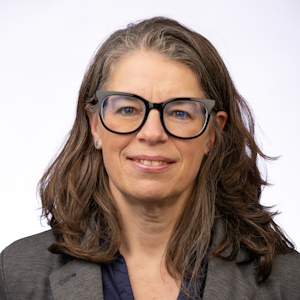
20 Questions with Dr. Angela Eikenberry
UConn School of Public Policy
Angie, it’s been a year since you moved from Nebraska to Connecticut. Do you feel like you’re no longer a visitor and now a full-time New Englander?
Ha, yes, I think so! It hasn’t been a hard transition because everyone has been so welcoming. I’ve enjoyed settling into living and working in downtown Hartford and look forward to continuing to get more engaged in the community.
What makes Hartford feel like home? Any favorite “go-to” spots in the area?
I enjoy my daily walk through downtown between my apartment and the School offices in the Hartford Times Building. My path often takes me along Pratt Street, where there’s usually something fun or surprising happening, especially after work. I already have a few go-to places. Vaughan’s Public House is really good—I watched a lot of UConn Women’s basketball games there this past year. I also really like the Korean food at Sunberry and Hartford Prints for personal gifts throughout the year.
Are there any local partnerships or Connecticut-specific initiatives you’ve found particularly inspiring or promising?
We have so many great partnerships with public and nonprofit agencies in Connecticut. One partnership we restarted this year with the Capitol Region Council of Governments (CRCOG) is CT Policy Talks, which features discussions on critical policy issues affecting Connecticut residents. We’re also excited to kick off a partnership with the CT Conference of Municipalities, offering support and Public Service Executive Leadership Collaborative (PSELC) classes as part of the Connecticut Municipal Leadership Academy trainings.
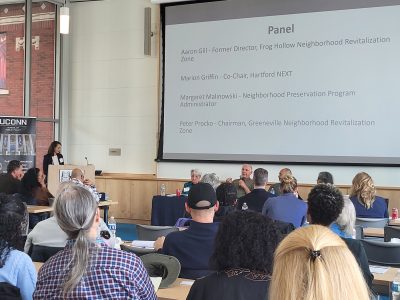
What differences have you noticed between the policy landscape in Nebraska and Connecticut?
Oh, my goodness—where to begin? The political values expressed in public policy are quite different. Nebraska leans more conservative, while Connecticut is more progressive. Nebraska is also unique as the only state with a unicameral legislature. I’m still getting used to a state government with both a House and Senate!
Let’s talk about SPP. How did you approach getting to know the SPP community—students, faculty, alumni, and partners—and what were some of the great discoveries and challenges?
I was lucky to have time before officially starting as Director to meet with many of our stakeholders, and I’ve continued to hold lots of meetings with faculty, staff, students, alumni, and partners. These have been great opportunities to listen and learn. One big takeaway is that our alumni are everywhere. Everyone seems to know someone associated with our School, and they’re doing incredible, impactful work in Connecticut and beyond.
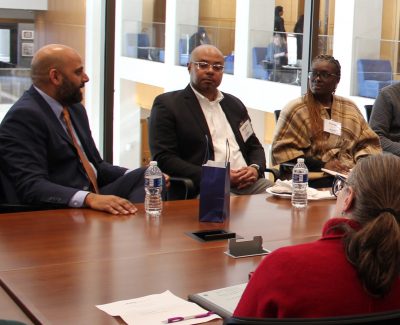
Challenge-wise, there’s been a lot to learn. There’s so much going on at the School, at UConn, and around the state. While the School is doing well overall, the university is facing significant budget challenges. We’re working to respond in a constructive, collaborative way that aligns with our values and maintains our strategic focus on student success, engaged partnerships, and impactful research.
What’s exciting is how open people are to having discussions about potential partnerships. The roundtable we hosted with Hartford Mayor Arunan Arulampalam came out of a conversation about better partnering with his office, especially since we’re right next door and his Deputy Chief of Staff, Cristian Corza, is an SPP alum.
Speaking of the classroom, tell us about the courses you taught this past year.
I taught PP 1001: Introduction to Public Policy in both the fall and spring semesters last year. It was a new prep for me, so a big learning curve—but also a great opportunity to get to know our undergraduates in Hartford and introduce them to tools for engaged citizenship. I invited many of our alumni, faculty, and staff to meet with students, so I learned a lot myself about the Connecticut policy landscape. The Hartford campus is an amazing place, with a great diversity of students. It’s a huge asset to be located in the Hartford Times Building, right next to City Hall and close to the State Capitol. Another alum, Jeff Hallin, helped organize a tour of the Capitol for our Public Policy 101 students. Students felt the tour was a powerful way to connect what they learn in class to real-world processes.
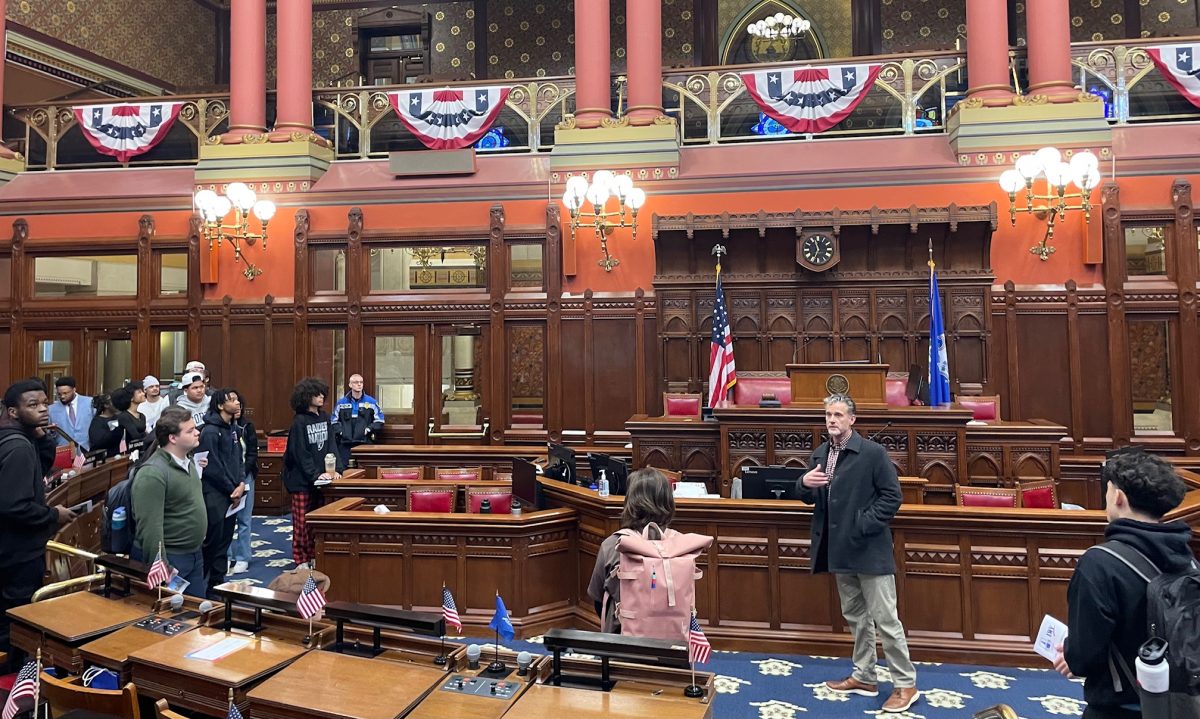
What are you most proud of accomplishing in your first year as Director?
I was able to connect one of my PP 1001 students—an incredible young woman advocating for special education reform in Hartford—with one of our MPA alums for guidance on strategic communications. Her story ended up being featured on CNN and in other national and local news outlets.
What are your top priorities for the School of Public Policy in the coming academic year?
There’s so much I’d like to accomplish. We’ll continue building connections across the School, university, and state. We’re prioritizing reaccreditation of our MPA program and for the first time accreditation of our MPP program. We’ll also keep working on how we tell our story—our students, faculty, staff, and alumni are doing amazing things, and we need to make sure people know about it!
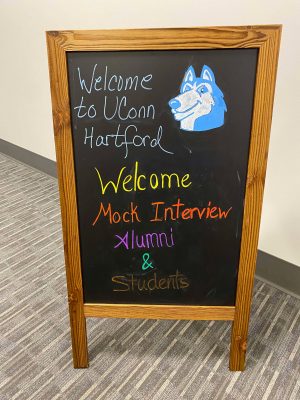
What opportunities do you see for faculty research and alumni/community engagement to expand under your leadership?
There’s a lot of opportunity for the School to support research that helps decision-makers shape good policy. IMRP plays a key role here. We’re trying to be ready to respond when legislators request studies. Connecting faculty research to real-world applications is essential. Faculty are producing nationally recognized work, and we want to better connect and translate that into tangible outcomes here in Connecticut. We’re already doing this but I hope can do more.
As for our alumni, they are already highly engaged through our alumni council and mentoring program. We love highlighting their career achievements. I’d love to expand their involvement, including financial support if they’re able, to invest in the next generation of public service professionals.
What excites you most about the School’s future?
That’s an impossible question—there are so many opportunities! We’re in the middle of strategic planning, and it’s a collaborative process. The School has a strong foundation and good support. The key is sustainable growth—meeting the state’s needs and continuing to strengthen the pipeline of public service professionals for government and nonprofit roles.
Tell us about the growth of the School. In particular, the Hartford-based Fellows program is beyond capacity. What makes it so popular?
The cohort model for professionals builds strong bonds among participants. The people in that program have a great experience and share that with their colleagues. Word of mouth, plus our outreach and promotion, have made it a very popular program. It has helped people advance their careers and expand their networks. Overall, our strong faculty, research, internship opportunities, and care for our students are what draw people to us. And, of course, we’re the only accredited MPA program in the state.
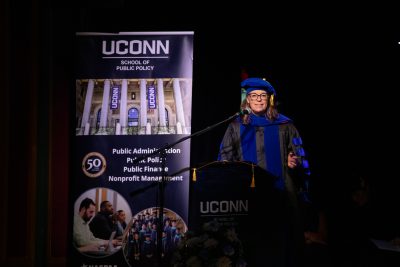
Is there a piece of advice or guiding philosophy that shaped your approach this year?
I’m focused on listening and figuring out where I can add or leverage value to sustain and grow the School. Mohamad Alkadry’s strong direction put the School in a great place, and I want to build on that momentum. People want to belong to a place where they’re welcome and part of something bigger than themselves. We’re creating opportunities for students to do meaningful work and serve the community. The better we do that, the greater our impact.
You’ve described yourself as a “caretaker” of the School. What does service leadership mean to you?
It’s not just about trying to help people bring out the best in themselves. It’s acknowledging how we bring out the best in each other. My job is to create systems that make that possible. I’ve been listening to a book on empowering leadership. I don’t love the word “empowering” because it implies giving power. Instead, I see my role as removing roadblocks so people can do what they do best.
A former dean I admired used to say, “What’s easy for me is harder for you.” So, conversely, if I take some of the burden off whatever it is to make things easier for someone else, it may be harder for me, but it frees people up to do even greater things. That proactive, problem-solving attitude really stuck with me. It’s a tricky balance because you don’t want to make decisions for other people or be patronizing. You do want to give them the tools they need to decide for themselves and the space and support to do their best work.
The School is launching two new social media campaigns: “SPP is the Place to Be” and “What SPP Means to Me.” Thoughts?
“SPP is the Place to Be” – We are perfectly positioned in the state to make an impact! In Hartford, we have the best situation in the heart of downtown, in a beautiful historic building, down the street from City Hall and the State Capitol. We’ve also recently expanded to offer our MPA Executive and Fast-Track programs at UConn Stamford’s thriving downtown campus where we have great partnerships with colleagues and alumni.
“What SPP Means to Me” – It’s a place of encouragement and action, committed to assisting municipalities, the state, and nonprofit agencies. We provide the support for students, faculty, and staff to do and be their best.
What do you miss most about Omaha, and is there something in Hartford that’s taken its place?
I miss the open spaces of Nebraska. Living downtown in an apartment is very different from having a house with a yard. But I’m on the 16th floor, so I still get to look out across the city. I try to go to Bushnell Park to get some “green time.” Leaving Omaha—where I lived most of my life—was hard, but Hartford has so much to offer: hiking, history, and more. I’m eager to keep exploring.
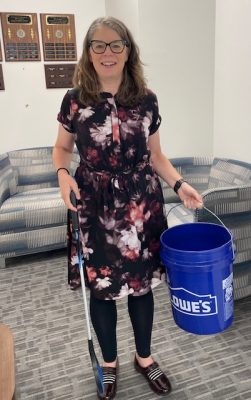
If you had one uniform ask for students, faculty, alumni, or partners, what would it be?
I’d ask everyone to consider how they can make their surroundings better. As a caretaker, I ask: how can we take better care of the School, our community, and each other?
Inspired by a friend from Omaha who started an organization called the Blue Bucket Project, my spouse and I safely pick up and dispose of trash as we walk around Hartford. I love it—you’re walking, maybe listening to a podcast, and also making your community better. That’s totally my personality: triple-tasking for good!
It’s a small act, but the impact can be huge. You can usually find me with my blue bucket on my walk to and from work.
Imagine if everyone did that.
Dr. Eikenberry is located at the School of Public Policy offices on the 4th floor of the Hartford Times Building. She can be reached via email: angela.eikenberry@uconn.edu.